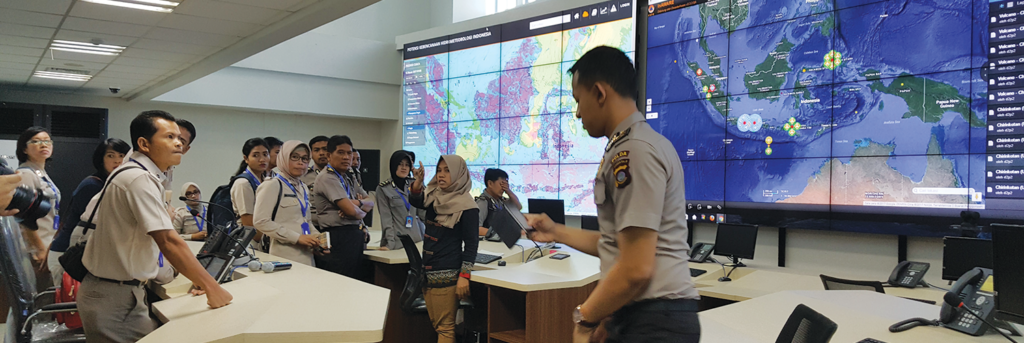Helping to Combat Zika and Other Global Threats
The Zika virus is just one of the latest threats the Pacific Disaster Center (PDC)—managed by the University of Hawai‘i—is helping to combat using an array of research and technology solutions.
Among their many global projects, research analysts at PDC have been monitoring and mapping outbreaks of the dangerous virus associated with severe birth defects and offering critical insight about its spread throughout Latin America and the Caribbean. Partnering with U.S. and foreign agencies to combat the mosquito-borne virus, which first sparked global attention during the 2016 Olympic in Games in Rio de Janeiro, the center is using public data to highlight areas most affected and map those most vulnerable to its continued spread.
“Knowing where cases are concentrated and how quickly they’re spreading is only one part of the picture,” said Ray Shirkhodai, executive director of the Pacific Disaster Center, adding that PDC is taking a proactive approach to look at areas with heavy rainfall, densely populated urban centers, and places with standing water where mosquito extermination and public health outreach is likely to be most effective. The center is also using its powerful disaster information system, DisasterAWARETM, to map the location of hospitals, public access to health services, and other policy-related information that could improve response capabilities during a future outbreak.
Comparative analysis tools and map visualizations like those created with DisasterAWARETM for the Zika outbreak can help nations gain crucial insight about their capacity to cope with disasters. Helping nations to increase their risk resilience—protecting people, property, and economic prosperity—is one of the key missions of PDC. The risk assessment tools within DisasterAWARETM support this aim by allowing nations to work proactively to reduce their risk of exposure, plan for future events, and avoid the incredible human and economic toll of an unmitigated catastrophe.
The Pacific Disaster Center has long partnered with U.S. Government Agencies (such as the U.S. Departments of Defense, State, Homeland Security, Health and Human Services, NASA, NOAA, etc.), United Nations agencies (such as UN-OCHA, IAEA), regional organizations (such as ASEAN in South East Asia, CDMA in the Caribbean, etc.), and numerous foreign government national disaster management agencies from the Asia Pacific to the Latin American regions to undertake projects that help nations mitigate disasters and reduce their risks and vulnerabilities.
By applying scientific research and technological innovation to solving the greatest disaster challenges, the center is constantly finding new ways to make its DisasterAWARETM products more useful. For instance, during the Nepal’s devastating 7.8M earthquake in April 2015, PDC’s collaboration with the global community to map the relief efforts within the impacted area helped the international responders better coordinate presence and aid. Similarly, the center has been present and supporting every major disaster worldwide, from 2004 Indian Ocean Tsunami, to the more recent 2010 Haiti Earthquake, 2011 Tohoku, Japan Earthquake, Tsunami, and Nuclear Emergency, 2013 Typhoon Haiyan in the Philippines, 2015 Ebola outbreak, and 2016 Hurricane Matthew, to name a few.
During Hurricane Matthew in November 2016, PDC produced numerous situational analysis products estimating impacts of the tropical cyclone as it moved across Jamaica and Haiti prior making landfall. Susan Hendrick, agency spokeswoman for the Federal Emergency Management Agency, said FEMA works closely with PDC to map storms and other hazards and to estimate the impact of disasters on local communities.
PDC’s joining the fight against Zika from the early emergence of this global threat, by mapping transnational occurrences and outbreaks, vulnerable populations, and predictive spreads was only one of the more notable efforts catching international news attention. The center produced and updated hundreds of maps and products, continually referenced by the domestic and international responding agencies, and all featured on the UN’s ReliefWeb.
However, PDC’s efforts are not all concentrated within its own headquarters in Hawai’i. The center has also collaborated with other nations to extend the use of its customizable platform, and enhance capabilities of the national aid agencies in Thailand, Vietnam, Indonesia and the Association of South East Asian Nations.
Over the past decade, PDC has been recognized for its work nationally and throughout the world. It continues to expand international projects and technological advancements and currently offers its flagship technology, DisasterAWARETM, at no cost to disaster management professionals. It has also widened its services to include a free new mobile application, Disaster AlertTM—allowing the people and their loved ones to stay safe anytime, anywhere they may be around the world.
The Pacific Disaster Center was established by the U.S. Government in 1996 with a mission to provide applied information research and technology to aid the worldwide disaster management and humanitarian assistance community. The University of Hawai‘i has served as PDC’s managing partner since 2006, when it was selected through a competitive process to manage the center. Over the years, PDC has expanded from serving the Pacific Rim to reaching out to the world. Based on the success of PDC, a new cooperative agreement was established in 2015 under the University of Hawai‘i, providing expanded funding opportunities to guide future innovations in disaster management research and technology.
University of Hawai‘i President David Lassner reflected on the work being done at PDC and its future by saying, “Science and technology play a pivotal role in advancing the well-being of people throughout the world and PDC has taken the lead in finding quicker, better, and less expensive ways to solve some of the toughest problems facing humanity in the twenty-first century. As extreme weather and other human-inflicted disasters remain on the rise, the need for reliable technology and advanced warning systems is even more pressing; as is the work of PDC to protect communities at home and abroad with new disaster science and technological innovation.”

